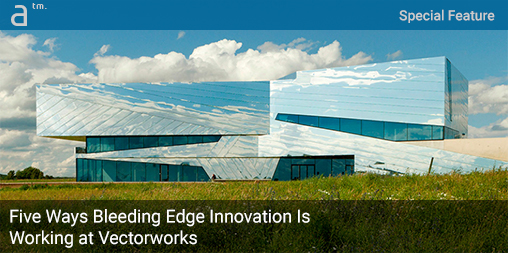Continued from page 1
AI and Machine Learning
While both types of teams are relatively new to not just Vectorworks but also similar software companies, the analytics data that comes in from user behaviors is mainly of interest for improving user performance.
“One of the ways we can improve the user performance for Vectorworks is by guiding the user’s next action,” says Sarkar. This is an area where the company is employing machine learning frameworks and an area where they are exploring AI (artificial intelligence). The company dumps user log data into several machine learning frameworks that in the end are trying to figure out things like after a user draws a wall or a rectangle, what do they generally do next? “We are interested in predicting what their next step wants to be,” he adds. One of the things the company is already doing is making changes to the user interface (UI) based on this machine learning analysis.
We are also very interested in how we can connect TensorFlow’s deep learning frameworks to the Marionette scripting environment.
The company has already noted in earlier Design Summits their interest in using machine learning to improve graphics in their rendering engines. A focus of late has been using AI algorithms to analyze photos and generate a rendering style from that photo. Such a focus fits the company’s reputation as being one of the most graphics-forward facing CAD/BIM companies, a legacy item of note largely stemming from their deep Macintosh roots. (see image 02, pg 3)
A third way the company is working with AI and machine learning is in exploring the use of deep learning algorithms to generate optimal design layouts in buildings. “These are not just algorithms but genetic algorithms that are aimed at helping the user optimally configure particular types of layouts around various criteria,” says Dr. Sarkar. These investigations can be quite useful for particularly complex program types in architecture, like around hospital design where one is trying to optimize travel time from a nursing station to a patient care unit. “The algorithms are the same ones that are being used in genetic research,” he adds, “where they are trying to look at the particular configurations of genes in pursuit of a cure for a disease.” Such algorithms look at all possible patterns within genes to drive towards medical treatments and cures and the folks at Vectorworks are taking a similar approach but towards optimal layout configurations in buildings.

01 – Vectorworks’ Marionette visual scripting environment is being explored with TensorFlow Deep Learning algorithms to explore new ways of designing using optimization techniques used in genetics and medicine.
To pursue these activities, the company is also tapping the deep learning frameworks from Google called TensorFlow. “We are also very interested in how we can connect TensorFlow’s deep learning frameworks to the Marionette scripting environment,” adds Sarkar. “We want to see what opportunities are there.”
The company is especially interested to see if there is a way to send the feedback loop data from the machine learning algorithms back to the design-forward algorithms in Marionette. In other words, a virtuous feedback loop would begin with a “design goals”-based Marionette process—perhaps generating three-dimensional forms for architecture—that gets affected by TensorFlow deep learning frameworks all in the pursuit of creating optimal building design arrangements that meet complex form and program criteria.
next page: Augmented Reality and Computer Vision: Impacts on BIM




Reader Comments
Comments for this story are closed